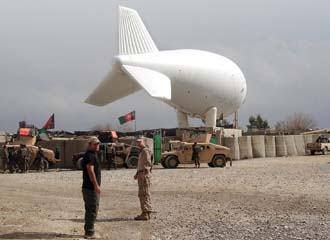A manpack radio enables on-the-move data flow in Afghanistan.

U.S. Marine Corps officials in Afghanistan mount two AN/PRC-117G radios onto an aerostat platform, effectively doubling the radio’s range.

Commanders in Afghanistan are experiencing a reduced decision cycle through use of a radio that extends the network down to—and provides situational awareness at—the lowest levels while allowing warfighters to access the network while on the move.
The AN/PRC-117G provides wireless, high-bandwidth communications, enabling applications such as streaming video, simultaneous voice and data feeds, collaborative chat, and connectivity to secure networks. Referred to by warfighters as the 117Golf, or simply the Golf, the radio offers wideband networking capabilities that give field commanders critical real-time information through a manportable system. In fact, the U.S. Marine Corps soon may begin systematically replacing Enhanced Position Location Reporting System (EPLRS) and Single Channel Ground and Airborne Radio System (SINCGARS) units with the Golf, according to Maj. James Robinson, USMC, a communications, future operations and amphibious officer with the I Marine Expeditionary Force, Camp Pendleton, California. Reducing the number of systems in the field would allow the Marines to streamline the logistics, maintenance and training required.
“It does and will change the way we fight because it helps reduce the decision cycle,” Maj. Robinson says. “Information flows faster bilaterally, up and down the chain of command, and decisions are made more quickly—and better decisions are made more quickly.”

The HMS program includes the handheld AN/PRC-154 Rifleman Radio, a two-channel radio known as the AN/PRC-155 “manpack,” and smaller radios designed for robots, unmanned vehicles and networked landmines. Source: General Dynamics
The AN/PRC-117G provides continuous coverage in the 30 megahertz to two gigahertz frequency band and allows software upgradeability. It uses a variety of waveforms, including among others, SINCGARS, Havequick II, very high frequency, ultrahigh frequency satellite communications, frequency modulation, audio modulation and the Adaptive Networking Wideband Waveform (ANW2) for high-bandwidth data operation. ANW2 is designed to be upgraded readily with the future Soldier Radio Waveform, a critical capability for the future Joint Tactical Radio System (JTRS).
The Falcon III can be carried in a backpack or mounted in a vehicle, and it enables simultaneous voice and chat communications as well as full-motion video capabilities. All of which means commanders down to the company and platoon levels can communicate from their vehicles as effectively as from the Combat Operations Center (COC).
And in some instances, the Marine Corps uses the radios to extend down to the platoon or squad level such capabilities as video feeds from unmanned vehicles. When necessary, troops below the company level could access such systems as the Advanced Field Artillery Tactical Data System, a network-centric fire support battle command system, or the Command and Control Personal Computer, which is used to track friendly forces and to display a common operating picture of the battlefield.
“There were several instances where we had to extend the network services down to the squad level for some of the more disparate squad observation posts. Sometimes, you have a squad observation post with 13 Marines and 13 Afghan National Army guys with them, so you’ll have a 26-man position, and they have a requirement for data at that level,” Maj. Robinson explains. “Some of the things we extend down would be full-motion video off of the Predators, Reapers or Scan Eagles. We would extend the chat capability, biometrics and email services. So, they literally had the capability to do everything at a platoon and sometimes squad level that you could do at the company or battalion level.”
Another critical feature is the radio’s ability to transmit position location information (PLI), which gives the Global Positioning System coordinates for the system’s user, allowing others on the network to keep track of friendly forces. Each data packet transmitted by the system includes combat-relevant PLI that can be displayed through a number of other systems, including Command and Control Personal Computer and FalconView and Google Earth mapping software. Because the PLI information is terrestrial-based, the information does not suffer the long latency periods associated with satellite-based blue force tracking, so the data is more up to date. “It’s changing blue force tracking from the long latency of the L-band satellite blue force trackers, which is instrumental in preventing fratricide and civilian casualties,” Maj. Robinson asserts.

The Marines have fielded more than 1,350 AN/PRC-117Gs and hope to deploy many more for ground command and control. The numbers may rise further as the systems are integrated into combat vehicles and other platforms. “Where we’re going in the future is that the Marine Corps is continuing to procure as many as we can with the money we have available to us,” Maj. Robinson states. The Marine Corps networking-on-the-move concept includes a point-of-presence vehicle packed with switches, routers and servers, and the Golf radio will be a key component in that configuration, he adds. “Networking on the move is going to provide us the ability to take all the 117Golfs that we put on the battlefield and extend that rifle company’s services over the horizon.”
Harris Corporation spent $250 million of its own research and development money to build the AN/PRC-117G. It is filling a critical need while warfighters wait for the JTRS, but it likely will be procured even after JTRS is available. The Defense Department announced in June that the JTRS program has been approved for low-rate initial production of up to 6,250 Rifleman radios and 100 Manpack radios. The milestone decision was reached two months ahead of the program’s current schedule.
http://www.afcea.org/signal/articles/templates/Signal_Article_Template.asp?articleid=2776&zoneid=320

No comments:
Post a Comment